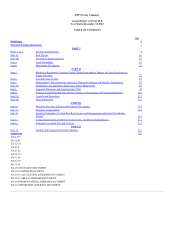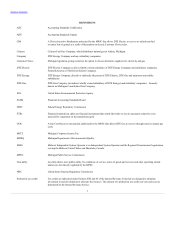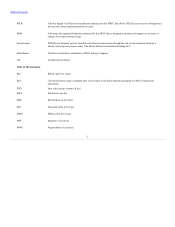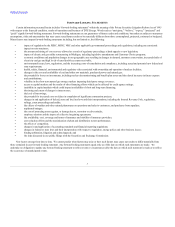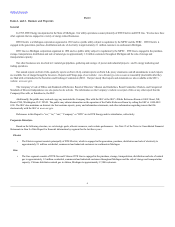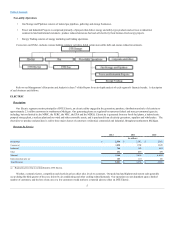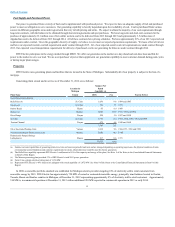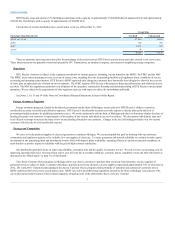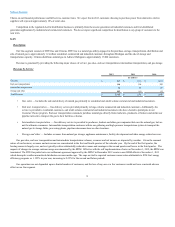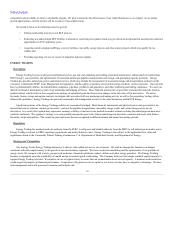DTE Energy 2012 Annual Report Download - page 9
Download and view the complete annual report
Please find page 9 of the 2012 DTE Energy annual report below. You can navigate through the pages in the report by either clicking on the pages listed below, or by using the keyword search tool below to find specific information within the annual report.
Table of Contents
DTE Electric owns and operates 671 distribution substations with a capacity of approximately 33,648,000 kilovolt-amperes (kVA) and approximately
430,600 line transformers with a capacity of approximately 22,306,000 kVA.
Circuit miles of electric distribution lines owned and in service as of December 31, 2012:
4.8 kV to 13.2 kV
27,856
14,585
24 kV
182
696
40 kV
2,278
383
120 kV
54
8
30,370
15,672
There are numerous interconnections that allow the interchange of electricity between DTE Electric and electricity providers external to our service area.
These interconnections are generally owned and operated by ITC Transmission, an unrelated company, and connect to neighboring energy companies.
Regulation
DTE Electric's business is subject to the regulatory jurisdiction of various agencies, including, but not limited to, the MPSC, the FERC and the NRC.
The MPSC issues orders pertaining to rates, recovery of certain costs, including the costs of generating facilities and regulatory assets, conditions of service,
accounting and operating-related matters. DTE Electric's MPSC-approved rates charged to customers have historically been designed to allow for the recovery
of costs, plus an authorized rate of return on our investments. The FERC regulates DTE Electric with respect to financing authorization and wholesale electric
activities. The NRC has regulatory jurisdiction over all phases of the operation, construction, licensing and decommissioning of DTE Electric's nuclear plant
operations. We are subject to the requirements of other regulatory agencies with respect to safety, the environment and health.
See Notes 3, 10, 11 and 19 of the Notes to Consolidated Financial Statements in Item 8 of this Report.
Energy Assistance Programs
Energy assistance programs, funded by the federal government and the State of Michigan, remain critical to DTE Electric’s ability to control its
uncollectible accounts receivable and collections expenses. DTE Electric’s uncollectible accounts receivable expense is directly affected by the level of
government-funded assistance its qualifying customers receive. We work continuously with the State of Michigan and others to determine whether the share of
funding allocated to our customers is representative of the number of low-income individuals in our service territory. We also partner with federal, state and
local officials to attempt to increase the share of low-income funding allocated to our customers. Changes in the level of funding provided to our low-income
customers will affect the level of uncollectible expense.
Strategy and Competition
We strive to be the preferred supplier of electrical generation in southeast Michigan. We can accomplish this goal by working with our customers,
communities and regulatory agencies to be a reliable, low-cost supplier of electricity. To ensure generation and network reliability we continue to make capital
investments in our generating plants and distribution system, which will improve plant availability, operating efficiencies and environmental compliance in
areas that have a positive impact on reliability with the goal of high customer satisfaction.
Our distribution operations focus on improving reliability, restoration time and the quality of customer service. We seek to lower our operating costs by
improving operating efficiencies. Revenues from year to year will vary due to weather conditions, economic factors, regulatory events and other risk factors as
discussed in the “Risk Factors” in Item 1A. of this Report.
The electric Customer Choice program in Michigan allows our electric customers to purchase their electricity from alternative electric suppliers of
generation services, subject to limits. Customers choosing to purchase power from alternative electric suppliers represented approximately 10% of retail sales in
2012, 2011 and 2010. Customers participating in the electric Customer Choice program consist primarily of industrial and commercial customers whose
MPSC-authorized full service rates exceed market costs. MPSC rate orders and 2008 energy legislation enacted by the State of Michigan have placed a 10%
cap on the total potential Customer Choice related migration, mitigating some of the unfavorable effects of electric Customer
7


